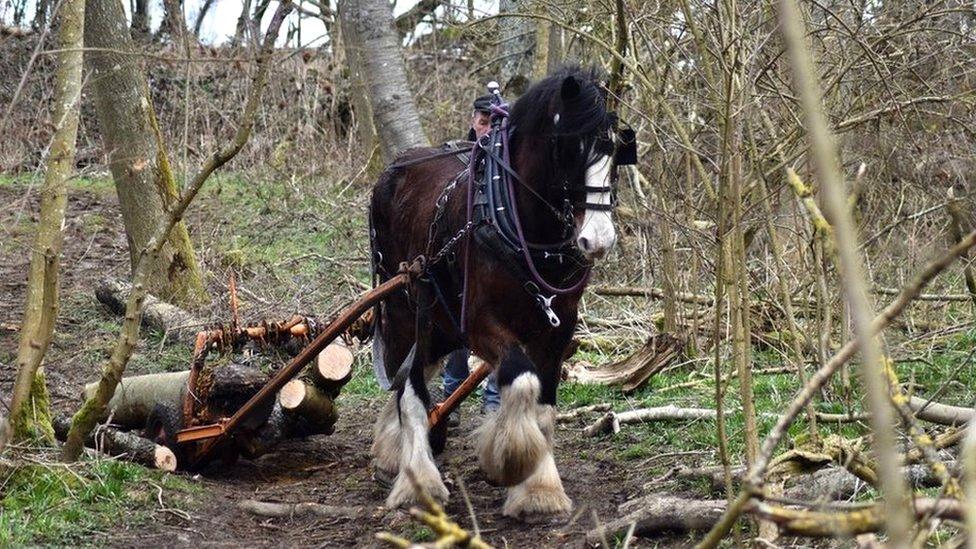Trees that fell in UK storms given new life
- Published
- comments

One park has special horses which can move branches out of the way
You may have noticed in your local park or woodland, fallen trees still on the ground from the recent storms.
When Storms Dudley, Eunice and Franklin battered the UK in one week in February, it uprooted thousands of trees.
Pines, oaks and beech trees in forests, parks, gardens and even playgrounds all came down in the powerful winds.
But when a tree falls it isn't always the end of its journey, here are some of the ways trees across the country found a new life.
Do you have a favourite tree? Let us know in the comments below.
A home for wildlife
Richmond park in London had 60 trees come down in storm Eunice including some very old oak trees. To move branches which were blocking pathways the park used their resident shire horses.
The special horses are used for work in the park because of their gentle tread which doesn't compact the earth like heavy machinery.
The dead wood wasn't taken far but moved into wood piles to create habitat for insects and bugs to boost the biodiversity of the park - for example providing a place for stag beetles to thrive.
If you've noticed lots of sticks and branches left over from the storms, how about trying to make a bug hotel?
"No tree lives forever as they are susceptible to extreme weather, disease and age. But while these trees are no longer alive, they can still support a wealth of wildlife," said Michael Rowland, head of park operations at Royal Parks.
Benches for the community
Bude residents were able to make suggestions on what to do with their beloved Triangle tree which came down in storm Eunice
When a large tree was toppled by storm Eunice in the middle of Bude town centre in Cornwall, residents were given a say of what should be done with it.
When Bude Stratton Town Council asked the public what it should do with the 23 tonnes of wood from the 80-90-year-old Monterry cyprus tree they got over 200 suggestions.
Ideas ranged from benches to a sculpture of a surfboard and even chess boards!
The council has now agreed to make street furniture using some of the wood.
They also plan to invite artists to create artworks for the town and offer off-cuts to community groups and individuals who want to have their own memento of the 'triangle tree'.
'Breathing life into dead wood'
Could some of the storm damaged trees become a sculpture like this?
The people of Bude are not the only people in the UK to want to mark a tree that fell in the storm in a creative way.
Mike Burgess is a wood sculptor and chainsaw artist.
He says he never carves on a living tree.
"The material I use is from trees, so when a tree comes down for whatever reason people think about the option of what to do with it"
He has already had lots of requests from people who have had trees come down in the recent storms.
Mike is a wood sculptor who carves dead trees into art
"People say to me 'we're pretty devastated that this tree has gone down in the storm and we'd like to make something to remember it by'," he says.
Mike uses all bits of the tree including tree stumps. He says many people don't realise they can make a feature out of it.
He gets requests from individuals as well as parks and even schools.
"It's breathing life into dead wood," he says.
Planting new trees
The storms devastated some areas, but there can be some positives for the environment.
Scotland was particularly affected by Storm Arwen in November 2021, losing around 4,000 hectares of woodland (about 4,000 rugby fields).
"It looks messy, but it's not a big disaster conservation-wise," says from George Anderson from the Woodland Trust.
In many places, the trees that were lost were mostly one type of species, George says.
In Kinclaven Bluebell wood, for example, it was the commercial spruces that were blown over not the mighty oaks.
In many cases, organisations like the Woodland Trust already planned to replace the trees to create a more diverse forest.
Planting new trees is a chance to plant different varieties which will be better for resilience and biodiversity
George says creating a patchwork of trees in their place should provide more protection from extreme weather in the future. It will also protect against tree disease which could spread fast through just one species.
Biodiversity is a measure of how many different species live in an ecosystem.
And planting mixed species of tree is also better for biodiversity, providing different types of habitat for the creatures of the forest.
George says it's in the nature of a tree to eventually die or fall in the wind, but it doesn't mean that it's not providing life to something else.
Like the trees in Richmond park that have become habitats for insects, George says when trees are dying they can be most valuable.
And in their place new trees can be grown.
- Published20 January 2020
- Published21 February 2022
- Published17 May 2021
